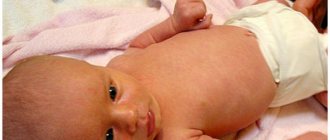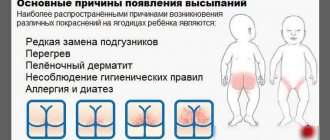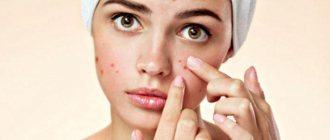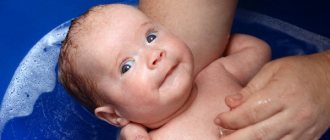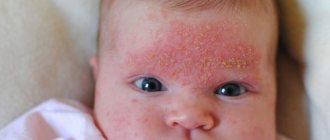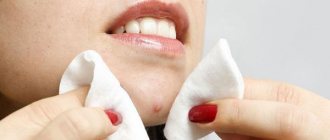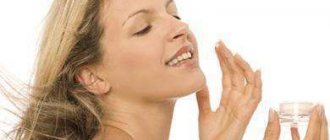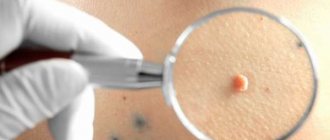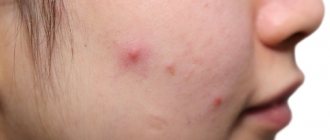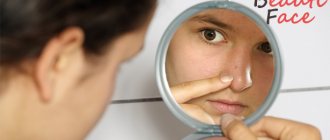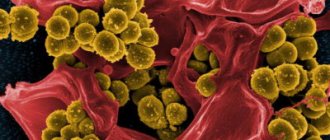If redness on the skin and pimples on the child’s face do not go away for a long time, it is better to show the baby to the pediatrician, because at first glance, harmless pimples may indicate the progression of a dangerous pathology in the body, which is important to diagnose and begin to treat in a timely manner. Even a 6-month-old baby can develop a rash on the delicate skin. If parents do not know its nature, self-medication is contraindicated.
The main causes of acne in children
Acne on a child's body can appear for a number of reasons. These may be:
- Teething. This is a common cause of acne on the face of a child. Most often, such pimples are localized around the mouth. This is due to the fact that during this period babies experience increased salivation. Acne goes away as soon as the period of eruption and drooling ends.
- Allergic reactions. Large and small red pimples in a child may be one of the manifestations of allergies. Such rashes appear suddenly and are sometimes accompanied by itching. If, in addition to acne, the child has a runny nose and sneezing (without other signs of a cold), then the allergic origin of the acne is beyond doubt. It is necessary to eliminate the allergen and the rash will go away.
- Miliaria (milliaria). Small pimples on a child's body can be a manifestation of common heat rash.
- Reaction to vaccination. Such reactions can be individual, including the appearance of a rash. If acne appears soon after vaccination, you should immediately show it to your doctor.
- Skin contamination. Children's skin is very delicate and requires careful care and cleaning. If the skin is heavily soiled, inflamed and purulent acne may appear in the child. In this case, there is also a high risk of infection.
- Frostbite, sunburn, chapping. Adverse weather conditions can have a significant impact on children's sensitive skin. In this case, you need to be careful and use special protective creams.
- Acneiform rash. This is the name given to acne in an infant that appears as a result of the mother taking certain medications during pregnancy: steroids, drugs with lithium or phenytoin. It may also be a consequence of certain diseases of the mother.
- Insect bites. Swollen red pimples in a child that are unevenly located on different parts of the body can be the result of insect bites. It is important to prevent this by using repellents, as sometimes bites can lead to severe allergic reactions, as well as exposure to certain diseases and parasites.
- Streptoderma. This is an infection of the skin with streptococci. Streptoderma comes in various forms. Some of them cause red water pimples in the child.
- Staphylococcal skin infection (vesiculopustulosis). When infected with staphylococci, white and purulent pimples appear in the child on different parts of the body. This disease can be very dangerous and requires immediate medical attention.
- Children's infectious diseases. Acne on different parts of a child’s body can be the result of various infectious diseases (chickenpox, measles, meningitis, rubella and others).
- In this case, in addition to acne, children also develop other signs of these diseases: weakness, sore throat, chills, fever, headache, etc.
- Intestinal dysbiosis. This condition is characterized by the appearance of small pimples on the child’s face, eyebrows, scalp, and sometimes all over the body. The affected areas of the skin often itch.
- Diabetes. Pimples on a child's bottom, as well as in the genital area, can be one of the signs of diabetes. Acne is caused by high levels of sugar in a child's urine.
- Puberty. Red, black and white pimples in a teenage child appear due to changes in hormonal levels. At this age, children may develop acne, blackheads, open and closed comedones. This is usually an age-related phenomenon and goes away on its own as the child grows older. However, during this period it is necessary to teach the child careful skin care so that such rashes do not become permanent.
Treatment methods for white pimples in children
Typically, childhood acne goes away on its own, but parents can speed up the process. To do this, you need to pay more attention to daily hygiene procedures. Even a small child needs to be washed and bathed every day.
This helps cleanse the skin of the face, remove excess sebum from it, and prevents blockage of the ducts of the sebaceous glands. As an additional precaution, you can use boiled water.
It is not necessary to use soap and cleansers - it is enough to use them once a week, and in children under two months - less often. Daily use of baby soap, shampoos and bathing gels is only permissible from six months.
If the baby does not have allergies, you can wash him with herbal infusions (it is important - water infusions, not alcohol tinctures). The dilution of infusions should be no less than 1:6. Before washing your baby with herbs, you need to do an allergy test on a small area of the body.
If any unpleasant symptoms appear, the procedures should be stopped immediately. It is important that washing with herbal infusions is a therapeutic procedure that should be performed only if there are symptoms of the disease.
To further improve the health of your baby’s skin, you need to spend more time in the fresh air, but not in direct sunlight. Even in winter, it is necessary to regularly ventilate the child’s room.
In addition, the mother should pay attention to her diet - do not eat anything that can cause allergies, eat more vegetables and fruits.
If the child is bottle-fed, then it is necessary to reduce the one-time amount of formula or change it completely (in this matter it is better to consult a pediatrician).
Acne in a child in the first months of life
Of great concern to parents is the appearance of acne in a small child (infancy).
Acne in newborns
At the same time, acne can appear on the face or cover the entire body. This is how a skin disease called “newborn acne” (acne neonatorum) manifests itself.
Why does acne appear in children?
It usually appears within six months from the birth of the baby, and about 20% of newborn children suffer from it.
Sometimes even pediatricians confuse newborn acne with atopic (allergic) dermatitis or other types of rash, so it is important for parents to know the distinctive signs of this disease.
Causes of acne
- The appearance of yellowish, whitish-pearly or white pimples in a child, looking like papules or pustules.
- No comedones.
- Pimples are located in close groups, sometimes merging into large spots.
- Frequent areas of rash: all areas of the face, back of the head, penis (in boys). Much less commonly, the rash appears on the neck and upper chest.
Why do small white pimples appear on the face that cannot be squeezed out?
Milia, or white pimples, are a type of acne that occurs primarily in adults and adolescents, although it is occasionally seen in newborns. In their structure, these are microscopic cysts filled with fluid and keratin accumulations with a small inclusion of fat.
There are several reasons for their occurrence. Hereditary predisposition, hormonal and metabolic disorders, vitamin A deficiency, excess sunlight and inappropriate cosmetics play a role.
Milia are most often located under the eyes, on the upper eyelid, on the forehead and cheekbones; extremely rarely they can be detected on other parts of the body. It is impossible to squeeze them out, since their structure is quite deeply connected to the skin.
Most often they affect middle-aged men, but according to more modern data, milia occur regardless of gender.
Causes of acne in newborns
Neonatal acne is the subject of specialist study, so all the causes of its occurrence have not yet been identified.
Acne in children in the first months of life
Let us note only those that have already been proven. And this:
- excess content of maternal hormones that are passed on to the baby during the intrauterine period;
- restructuring of the baby’s own hormonal system;
- excessive secretion of the sebaceous glands;
- clogged pores and hair follicles of the skin;
- excessive formation of lipophilic yeasts, which lead to inflammation.
Treatment of acne in newborns is carried out after an accurate diagnosis has been established and numerous other dermatoses that occur in young children have been excluded. As a rule, in order for the examination to be comprehensive and treatment to be adequate, the child will need to be shown not only to a pediatrician and dermatologist, but also to an endocrinologist and an allergist-immunologist.
It's worth remembering
As a conclusion, I would like to remind you once again that milia are typical for 80% of newborns. They occur due to blockage of the sebaceous glands. White papules are small in size, most often localized on the nose, but can also be on the baby’s cheeks, forehead, and chin. It may appear on one or more sides of the face.
White spots in a newborn, if they are caused by physiological characteristics of the body, do not need to be treated. In special cases, when the skin cannot cope on its own, the doctor may prescribe the use of ointments containing panthenol. But this happens quite rarely.
The appearance of acne on the nose in children can be associated with various factors. These include various pathologies, changes in the balance of hormones in the body, and insufficient skin care. To cope with the disorder, you need to contact your pediatrician in time.
The specialist will examine the baby and, if necessary, prescribe additional tests. This will help deal with the problem and avoid its occurrence later.
Acne in a child during the first years of life
Acne in a child of the first year of life can also be one of the types of acne - childhood acne (acne infantum). Most often, they are associated with an excess of testosterone in the blood plasma caused by metabolic disorders. With this disease, acne on a child’s face often becomes inflamed, which is why they sometimes leave scars.
Most often, childhood acne affects boys, appearing between the ages of three months and a year or two and sometimes persists up to three or four years.
To summarize, we can say that the appearance of any type of acne in a child should be a reason to consult a doctor and find out the exact cause of its appearance.
Among all types of rashes on the face or body, purulent acne is the most dangerous. They can appear at any age.
But if such rashes in adults require special care, then purulent acne in a child should not be ignored at all.
What reasons can influence their occurrence and how to treat these acne?
- All information on the site is for informational purposes only and is NOT a guide to action!
- can give you an ACCURATE DIAGNOSIS !
- We kindly ask you NOT to self-medicate, but to make an appointment with a specialist !
- Health to you and your loved ones!
What should parents do if acne appears?
When a child has acne on his face, not all parents know what to do. Therefore, you need to try to prevent their occurrence. To prevent rashes in preschool children, you must first monitor their diet. In kindergarten or visiting friends, a child may eat a product that will cause him an allergy.
Particular attention should be paid to possible locations of acne. Having noticed a couple of pimples on the face, you need to immediately examine the child’s entire body. Some infectious diseases begin with rashes on the face and spread throughout the body. If you don't pay attention to small pimples, you may miss the symptoms of a dangerous infection.
Why do they appear?
The occurrence of purulent acne can be influenced by a variety of factors.
They represent a strong inflammatory process, accompanied by the formation of pus in the hair follicle. This is preceded by bacterial infection of the sebaceous gland secretion.
Rashes on the body (the photo shows the variety of types of such rashes) can have very different causes.
The most common are as follows.
- Hormonal imbalance. First of all, the activity of the sebaceous glands is caused by male sex hormones. Hormonal changes can be observed in adolescence, during pregnancy, in different phases of the menstrual cycle, due to taking hormonal medications.
- Hyperkeratosis. This is a condition accompanied by thickening and compaction of the upper layer of the epidermis.
- Insufficient skin cleansing. Washing with water is not always enough to completely cleanse the skin, so remaining dirt quickly becomes a breeding ground for bacteria.
- Improper skin care.
- Abuse of decorative cosmetics or use of comedogenic skin care products.
- Frequent situations of nervous tension.
- Diseases of various origins . Among them are those that are sexually transmitted. Adults do not always manage to avoid “childhood” infections if immunity to them has not been formed in due time. With psoriasis, red pimples may also appear, which quickly merge into dense plaques.
Children may have their own reasons leading to the formation of purulent acne:
- teething, accompanied by active salivation;
- prickly heat, which occurs due to overheating of the body;
- unfavorable environmental factors;
- intestinal dysbiosis;
- infectious lesions - staphylococcal infection, streptoderma.
Let's take a closer look at some factors.
Irritation
Skin irritation can be caused by rubbing with clothing or exposure to external factors (weather, household chemicals).
As a result, the top layer of skin is damaged, reddened, inflamed areas and small rashes appear on it.
Damaged epidermis cannot serve as a good defense against the penetration of bacteria. And as they develop, new pimples with purulent contents appear.
Photo: perioral dermatitis
In babies, irritation can easily occur around the mouth due to increased salivation.
Saliva itself is an irritating factor for the epidermis, so the formation of acne with subsequent infection is not uncommon.
Allergic reactions are a common cause of skin rashes.
Photo: manifestations of diathesis
- They can appear on almost any area: not only on the face, but also in skin folds and on the butt.
- Often small pimples merge into larger formations and begin to get wet.
- The situation is worsened by severe itching, which is sometimes accompanied by scratching the affected areas.
All this contributes to skin infection.
Viral diseases
Chickenpox, measles, meningitis, rubella and some other viral infections may be accompanied by skin rashes.
Usually in this case there are other symptoms of the presence of the virus in the body: fever, weakness, headache.
In such cases, consultation with a doctor is required.
Insect bites
Photo: rashes after insect bites
- Insect bites on the skin look similar to pimples.
- They are red, compacted, with a raised middle.
- But such formations do not have purulent contents.
- Another thing is that bites often cause severe itching. By scratching them, you can easily damage the epidermis and introduce an infection there. In this case, a purulent formation may appear at the site of the bite.
- Pimples from bites are located singly, without merging into groups. They may appear in places not specific to the rash (for example, on the knee) or be scattered throughout the body.
Types of rashes
To determine the types of acne on a baby’s face, you need to take a close look at them and determine what acts as a provocateur. You can also find photos on the Internet and focus on them. Only a doctor can make an accurate diagnosis, but every mother can recognize the most common types of pimples.
Acne
Most often, this problem can be diagnosed at 2-3 weeks of a baby’s life. Reddish pustular pimples appear on the cheeks. The main reason is hormonal changes in the child’s body. This disease is absolutely safe and goes away within 24 months of the baby’s life.
Diathesis
Pinkish rashes cause stomach upset and allergic reactions to external irritants. Pimples can be seen not only on the face, but throughout the body. The main cause of the disease is washing powder, powder, cream, type of fabric. To establish an accurate diagnosis and prescribe treatment procedures, it is necessary to visit a pediatrician.
Ritter's disease
, whitish blisters can be seen near the baby's mouth , which very quickly spread to other parts of the body and face. After this, the pimples burst and the skin begins to peel off. This disease is of an allergic and infectious nature. The problem can only be treated under the strict supervision of a doctor.
Seborrheic dermatitis
The disease is characterized by scaling and peeling of the skin on the ears. Experts say that the main reason is hormonal imbalances in the body and the development of yeast fungi. The disease goes away on its own in 2-4 weeks, but consultation with a pediatrician is required.
Video: “About acne on the cheeks of a one-year-old child”
Pimples that appear can be of different types.
In many ways, this feature allows us to determine the cause of the rash:
- papules - red pimples, with a raised upper part that has no contents;
- pustules - formations with a white tip, which indicates the presence of purulent or watery contents inside;
- nodes - subcutaneous inflammation, which manifests itself as redness and thickening of the epidermis;
- cysts are large internal pimples, red or bluish in color, which are painful when palpated.
Watery
Watery pimples resemble colorless blisters, protruding like a hemisphere above the epidermis.
Photo: allergic rash
They may be a sign:
- allergic reactions - in this case the pimples are small, located in a close group;
- diaper rash - a similar rash can appear when the body overheats, especially in children of the first year of life; if the child’s skin does not receive proper care on time, then the miliaria can transform into a secondarily infected purulent rash;
Photo: chickenpox rash
- chicken pox - in this case, blisters appear very quickly, growing literally before our eyes from small reddish spots, first in the face and neck, then on the stomach, back, arms and legs, there are additional symptoms in the form of fever, itching;
Photo: lesion by molluscum contagiosum
- molluscum contagiosum - in this case, the vesicle that appears usually has a slightly depressed center with darkening inside it;
- herpes is a viral infection that manifests itself during periods of weakened immunity.
Most watery rashes require special treatment, so if you notice such pimples, you should consult a doctor.
Red in babies
Red rashes in infants may not pose a danger and do not require treatment.
Photo: baby acne
But parents are unlikely to be able to determine the severity of the situation on their own.
Red pimples can appear on a child’s body in the first six months of life, most often immediately after birth.
This is the so-called newborn acne. They indicate that the mother’s hormones entered the baby’s body, which caused a surge in the activity of the sebaceous glands.
There is no need to treat, let alone squeeze out, such pimples.
They go away on their own within a few days.
But this type of rash must be diagnosed by a doctor.
Folk remedies for getting rid of pimples at home
Folk recipes offer a variety of ways to get rid of white pimples. They are not always effective, but sometimes they can bring results. A variety of remedies are used for treatment - herbs, medicines and foods.
One of the simplest recipes is washing with calendula. To do this, you can buy calendula tincture at the pharmacy and dilute it in water in the proportion of 1 tablespoon per 100 ml. You can wipe your face with the resulting solution while washing or make compresses.
Another way to use calendula (marigolds) is to infuse a collection (you can buy it at a pharmacy or collect it yourself). To do this, pour boiling water (2 tablespoons per glass) over dried calendula flowers, leave for 24 hours, then dilute the resulting infusion by half and use it for washing.
Another popular remedy is a potato mask. The ingredients for it can be found in your own refrigerator. To do this you will need one boiled potato, 2 tablespoons of cream, an egg yolk and a teaspoon of honey.
Mash the potatoes, add the rest of the ingredients, mix thoroughly and apply to the face, paying special attention to problem areas. The result is achieved with regular use in no less than a month. A mask of cottage cheese and cucumber juice is also used.
The aspirin mask is prepared as follows: you need to soak 10 aspirin tablets in water and mash to a pulp, add to them a tablespoon of honey, and a tablespoon of Vishnevsky ointment.
The resulting mixture can be applied to the face in the morning. Before using such a mask, you must do an allergy test on a small area of skin (best on the shoulder or thigh).
Rashes in babies in the first years of life
In infants and children of the first years of life, rashes may appear for the following reasons.
Photo: milia in a newborn
- Milia - occurs due to blockage of the sebaceous glands due to imperfection of their functioning. It looks like a lot of small white pimples on the face. There is no need to worry about this, nor do you need to do anything.
- Miliaria should not be a cause for concern, but serves as a signal that the child is being overly wrapped up.
- Allergic reactions – such rashes can often be found on the cheeks of a one-year-old child. They arise due to errors in the nutrition of a breastfeeding mother or as a reaction to introduced complementary foods. Allergies can also occur to baby skin care products and washing powder. Accordingly, a rash appears in places of such contact.
- Dysbacteriosis - imperfection of the digestive system can also manifest itself as a rash on the face. Parents usually notice such pimples on their child’s cheek. A doctor can make such a diagnosis; research data will be required.
It is not surprising that acne in a baby causes concern for parents.
Therefore, do not hesitate to contact your pediatrician with any questions.
Preventive measures
Almost all acne in babies is not dangerous. Their occurrence can be easily avoided if you follow a number of measures:
- watch your diet;
- if there is a reaction to the mixture, replace it;
- properly care for your baby and maintain hygiene;
- give the baby air baths;
- wash your baby’s underwear with specially designed powders.
If acne does not go away for a long time and bothers the newborn, doctors usually prescribe medications: Panthenol, Bepanten or Zinc ointment.
Preschool and school age
Acne rarely appears in preschool children until puberty.
Therefore, if this happens, parents should pay special attention to this.
Photo: teenage acne
They can arise due to:
- hormonal disorders and malfunctions of the adrenal glands;
- infectious diseases;
- early puberty;
- miliaria;
- metabolic disorders.
All conditions are serious and require special treatment.
Locations
Purulent acne can occur on any part of the body.
Most often it is the head, chest, shoulders and back. Less often - stomach, arms, leg, butt. Most rarely, such pimples appear on the palms and soles.
The entire scalp area is prone to acne.
Photo: prickly heat on a baby’s head
They can be found on the face, in the hair, in the mouth and in the ear.
The face is the most common area for rashes. There are large sebaceous glands here and it is open to external influences.
Pimples on the forehead often appear due to:
- poor nutrition;
- gastrointestinal diseases;
- improper skin and hair care;
- hormonal imbalances.
The situation can be complicated by the presence of bangs, which make it difficult for the skin to breathe and can serve as a source of bacteria.
Very often, acne in the mouth appears due to a viral or bacterial infection.
Photo: follicular tonsillitis
Purulent formations in the throat are a sign of complicated sore throat.
Pimples on the lip are usually small in size and have a clearly visible white head. They are formed due to the penetration of bacteria into the pores of the skin.
This happens due to:
- pollution;
- touching lips with hands;
- low-quality lipstick;
- Habits of holding pencils and pens in your mouth.
Such rashes should be distinguished from herpes, which is characterized by blistering formations.
The rash on the tongue is usually white.
Photo: thrush in the mouth
But they can be a sign of thrush or stomatitis. A specialist can determine exactly.
- Typically, stomatitis is accompanied by an increase in body temperature, which is not typical for candidiasis.
- Such rashes are equally painful, so they need to be treated as soon as possible. Moreover, they do not go away on their own.
On the chin
Rashes on the chin occur due to hormonal disorders and malfunctions of the endocrine system.
Here you will need to consult an endocrinologist.
Pimples on the nose can be of different types.
- They often appear due to hypothermia or pollution.
- Purulent subcutaneous formations may be a sign of problems with the cardiovascular system or liver.
Pimples on the hands can be caused by excessive dry skin, hypothermia, contact with household chemicals, or be a sign of allergic reactions.
How to cure acne on your face at home? Find out here.
On the palms
There are no sebaceous glands on the palms, so acne in this area should be of concern.
It is best to consult a dermatologist.
On the neck and shoulders
- Rashes on the neck can be a sign of hormonal imbalances, especially if similar ones are present on the chin.
- But a rash can also appear due to skin irritation from clothing items and subsequent bacterial infection.
- If purulent pimples appear on the shoulders, then perhaps the whole point is due to the excessive covering of this area by clothing or bag straps. In summer, they can be caused by hair falling over the shoulders or excessive tanning.
Breast rashes are usually a sign of hormonal imbalance or taking hormonal medications.
Pimples on the stomach are a sign of infectious lesions.
It can be not only measles or rubella, but also syphilis. There is no need to treat them yourself.
Pimples on the butt easily appear due to wearing synthetic underwear, which prevents the skin from breathing normally.
Photo: rashes on buttocks
Purulent pimples on a child's bottom can be a sign of diabetes.
The appearance of purulent acne on the legs should also not be ignored.
They can be a consequence of hair removal or infectious diseases.
On my feet
Acne is rare here, so if it appears, you should consult a doctor. At best, it may turn out to be prickly heat, at worst, an infection.
Pimples on the nose: causes for women and men. How to get rid of acne on your nose in one day?
The appearance of a baby in any family is a great happiness. However, now the parents bear great responsibility for his life and health. They begin to closely monitor his appearance and changes in behavior. White pimples on a newborn's face cause a lot of stress for his mother. This symptom may indicate the presence of serious abnormalities in growth and development.
The disease must be recognized in time and all efforts must be directed towards its elimination. Only in this case will it be possible to avoid serious consequences. Pimples in a newborn do not always indicate the presence of diseases in the body. The situation may indicate physiological changes and maturation of the body.
In any case, only a doctor can make a correct diagnosis based on test results.
White pimples in babies develop under the influence of negative external and internal factors. The symptom can be completely eliminated if the very cause of the negative development is removed.
Additionally, it should be noted that pimples on a baby’s skin can be not only white, but also red. Inside some of them, pus tends to accumulate. In this case, they look like a tubercle.
Pimples will go away quickly if you choose the right course of treatment.
White, non-inflamed pimples on the body are called milia. They are small in size and resemble a pearl in appearance.
If inflammation does not appear around this formation, then there is no need to worry. These pimples will go away on their own within a short time.
They appear against the background of insufficient development of the sebaceous glands. Against this background, fat begins to accumulate under the skin.
To eliminate milia, it is necessary to ensure proper skin care
Most often, no special treatment is required, but the pediatrician should monitor the development of the clinical picture. If the formations are not squeezed out, then scars will not remain after them.
With the birth of a baby, young parents have a lot of worries and troubles. Every pimple on a baby’s body can cause suspicion and a desire to urgently consult a doctor.
But it is worth knowing that there are physiological characteristics of the body to respond to the world around it. Thus, white spots on the nose of a newborn can greatly frighten the family. But in vain. They occur in 80% of babies in the first weeks of life.
Where do they come from? Is it possible to avoid their appearance so that the toddler’s skin remains perfect? We'll look at all this in the article.
The appearance of even a small spot on a child’s face causes many mothers a lot of trouble. And what unpleasant news it will be when they suddenly turn into pimples. The reasons why delicate children's skin becomes covered with such defects are very diverse. However, some neoplasms do not pose a danger, while others require immediate treatment.
1. Why do pimples appear on a child’s face? 2. Pimples on a child’s face: types and signs 3. Pimples on a child’s face - treatment Dr. Komarovsky about pimples on a child’s face, video
Sometimes, certain symptoms may appear before acne occurs. However, this does not always happen, and therefore, if you cannot independently determine the cause of the rash, you should contact a specialist. After all, the health of children is the main concern of responsible parents.
Pimples in children most often occur as a result of:
- Unstable hormonal levels.
- Excessive work of the sebaceous glands.
- Allergic reaction.
- Infections.
- Damage by pathogenic microflora.
- Improper skin care.
- Low quality cosmetics.
We suggest you familiarize yourself with a remedy for whiteheads on the face.
Depending on the cause, pimples may have a certain color and be accompanied by itching, swelling and redness of the skin. In some cases, body temperature may rise and general malaise may appear. It is undesirable to lose sight of all this, since children’s health is not to be joked about.
In most cases, you can find out the cause of acne in a child by its appearance, color and location. Age is also an important factor. This is due to the fact that at different periods of a child’s life, acne of a certain type may occur that is uncharacteristic for other ages.
In children, the most common types of pimples on the face are: Non-infectious:
- Prickly heat. It is a small rash in the form of blisters filled with liquid. There may be slight redness at the site of their appearance. As a result, infections can turn into purulent rashes. These small pimples appear on the face - forehead, nose and under the lower lip. Often located behind the ears.
- Hormonal acne in a newborn occurs due to the high content of the hormone estrol in the mother’s body. Most often, pimples of this type are located on the nose. They go away on their own within the first 10-14 days after birth.
- White pimples on the face, collected in small groups and less often alone, appear due to disruption of the sebaceous glands, their immaturity. Papules are characterized by the presence of yellowish or pearlescent content. They are mainly found in infants and can accompany them for up to 6 months.
- Allergic rashes in children are presented in the form of red spots, on which a small rash may form. They are almost always accompanied by itching and less often swelling.
Infectious:
- Scarlet rashes that affect not only the face, but also the throat and other parts of the body most often signal scarlet fever. The skin feels like sandpaper and becomes very dry. The disease begins with a sharp increase in body temperature to 39 degrees.
- Small pimples on the face with a slightly reddish rim and watery contents may be a manifestation of chickenpox. Their appearance begins with redness of the skin in the place where they will be located. In just a couple of hours they will turn into itchy blisters. The disease is accompanied by refusal to eat, increased body temperature, nausea and weakness in the body as a whole.
- A collection of blisters on reddened skin may be herpes. Before their appearance, there may be an increase in body temperature, weakness and soreness of the skin. In babies, saliva production most often increases. Mostly herpes settles on the lips.
- Children over 2 years of age may develop folliculitis. It consists of purulent rashes no larger than a grain. After a while, they become crusty and require treatment with antibacterial ointments.
All types of acne except whiteheads and hormonal acne in newborns must be treated. However, the methods of treatment for certain types differ from each other. In some cases, home procedures will be acceptable and desirable, but in others they can be harmful. For example:
- Infectious pimples can only be treated with medications prescribed by your doctor. It is impossible to do without consulting a specialist, since they are accompanied by a deterioration in the baby’s overall health. Moreover, these diseases are contagious, which obliges us to take timely measures and not delay treatment.
- To treat prickly heat in children, it is necessary to choose the right care cosmetics. It should be baby powder or cream containing zinc. This can be either an ordinary baby cream or, for example, desitin, bepanthen. It is also recommended to wipe damaged areas of the skin with a decoction of chamomile and calendula.
- An allergic rash is treated by changing the diet of the mother or the child. Therefore, it is advisable to keep a special diary during the time your baby is introduced to a new product. It should note the reaction that is displayed on a particular product eaten. As a result, the mother will know whether there is an allergy to this food product, or whether it is necessary to look for it in something else.
When pimples appear in children, you should never try to squeeze them out. It is not recommended to lubricate them with “adult” creams, no matter how “good” their composition is. Children's skin is very delicate and sensitive to any chemical products. Cosmetics for children are produced specifically to care for her.
The birth of a child is a great event in every family. It causes special trepidation and excitement among those who have become parents for the first time. Every breath, movement and cry of the baby is subject to close attention. Everything new and incomprehensible causes anxiety. Such things include white pimples on the nose of a newborn.
Many babies develop small white rashes on days 3-7 of life, which are located in groups of several pieces. It may appear as white pimples or dots. Such rashes are absolutely safe and are the result of the dermis adapting to new living conditions. Over time, they will go away on their own.
These pimples do not cause discomfort, therefore, if you notice that with its appearance the child has changed his behavior (became restless, eats, sleeps worse, etc.), tries to scratch it, or there are signs of inflammation (redness, fever, swelling) - you should immediately consult a doctor.
There are factors that, according to scientists, lead to their appearance.
Maternal hormones
During intrauterine development, the blood flow of the mother and fetus are one. This, in many cases, leads to the fact that maternal hormones enter the fetus's body. Their exposure can lead to the formation of white pimples on the baby’s nose, forehead, cheeks and butt. They do not bother the newborn in any way, they go away on their own and absolutely without a trace.
The health and well-being of the baby largely depends on the mother. If a nursing woman breaks her diet and consumes allergenic foods, such as chocolate, then this cannot but affect the skin of the newborn. The appearance of a rash, in this case, is simply inevitable. The main method of treating such a white rash is the mother's diet.
We suggest you familiarize yourself with Pimples in the mouth of an adult and a child (white, transparent): on the palate, cheek and lip
Clogged pores
In young children, in the first days of life, white nodules may appear on the face and body, protruding above the general surface. They are clogged sebaceous glands and are called milia.
When the sebaceous glands are activated, secretion is produced and accumulated. This occurs due to the underdevelopment of their excretory ducts, which are not able to evacuate all the secretions.
- 1 Acne and pimples in a child - what to do, causes, treatment
- 2 Acne in a child 4-6 years old
- 3 Acne in children: symptoms, causes, treatment, prevention, complications
- 4 A selection of effective methods for treating teenage acne in girls using medications and folk remedies
- 5 Pimples in a child. If a child has pimples on his face or body - what could be the reason and what to do?
Features of treatment
Before you begin treatment for purulent acne, you need to establish their cause.
It is also recommended to approach treatment comprehensively:
- review your diet towards proper nutrition;
- strengthen personal hygiene;
- take additional vitamin complexes.
Cosmetic procedures
Cosmetic procedures that can help:
- Ultrasound therapy – it promotes deep cleansing of pores, improvement of blood microcirculation in skin cells, and natural healing of the skin occurs;
- different types of peelings - also deeply cleanse pores, remove excess dead cells from the surface;
- mesotherapy – with the help of special medicinal mixtures, not only inflammation is eliminated, but also a comprehensive solution to skin problems occurs.
All cosmetic procedures should be carried out outside the period of exacerbation.
Medication
All medications should be taken only as prescribed by a doctor.
Photo: A doctor should prescribe medications to a child
Depending on the reason and recommendations will be different.
What can help:
- hormonal ointments - usually with hydrocortisone, soothe the skin and regulate the activity of the sebaceous glands;
- ion-colloidal solution of silver - has antibacterial properties, essentially not being an antibiotic;
- Antibiotics – fight bacterial skin lesions.
At home
Home methods should complement the treatment prescribed by a specialist, but not replace it.
They promote faster healing of acne and skin regeneration:
- tar soap – has an anti-inflammatory effect and does not dry the skin;
- sea salt – improves metabolic processes, helps skin heal without scars (used in the form of baths);
- salicylic alcohol - applied spot-on to dry out acne and relieve inflammation;
- hydrogen peroxide – used in diluted form, has antimicrobial and drying properties;
- zinc paste - promotes the healing of even deep acne without scars on the skin.
Is it possible to use chloramphenicol for acne during pregnancy? Find out here.
How to use boric acid solution for acne? Read on.
They should absolutely not be squeezed out, because the infection will quickly spread to neighboring areas.
Caution is especially required in relation to children. Any purulent rash in them requires mandatory consultation with a doctor.
How to get rid of white pimples
There are several different ways to eliminate white pimples. It is best to do this in a cosmetology clinic, where the treatment will be quick and effective. Professional cosmetologists use three treatment methods.
Curettage is used for isolated lesions. They are removed mechanically - they are pierced and scraped out with a curette along with the capsule. This prevents acne from appearing again in the same places.
In cases where there are too many pimples, electrocoagulation is used. The essence of the method is that, under local anesthesia, the skin is exposed to high frequency electric current.
This allows you to eliminate capsules that are located deep, and also helps with high density milia capsules. After the procedure, a crust forms on the skin, which peels off after a week.
To avoid inflammation, it must be treated with antiseptics. There is a risk of scarring on the skin.
Laser coagulation is the most expensive and effective way to treat milia. It allows you to eliminate even hard-to-reach capsules, and also avoid suppuration, damage to healthy tissue, and bleeding.
Video: “How to treat a boil”
Quite often, parents watch with fear as red pimples break out on their child on various parts of the body, including the face. The first thought is an allergy, although in fact the cause of this phenomenon may be other diseases, on which the prescribed treatment methods and the speed of the baby’s recovery will depend. Therefore, the first thing that is recommended to do in this case is to find out what factors provoked these rashes.
On their own, at home, it will be very difficult for parents to determine why red pimples broke out on their child’s body. They can only analyze their baby’s lifestyle and menu, which may cause this irritation. If the reason lies in malfunctions and disruptions in the functioning of various systems of a small body, it is better to consult a doctor as soon as possible for a timely diagnosis. Among the factors that provoke the appearance of a rash are:
- teething (accompanied by copious salivation);
- diaper rash;
- reaction to vaccination;
- failure to comply with basic hygiene rules;
- low-quality clothing made from synthetic materials;
- overheating of the skin (if too many things are put on the baby and he becomes hot), resulting in prickly heat (in the hospital, such pimples are called milliaria);
- allergies (it is necessary to identify what the baby reacts to so violently in order to exclude his contact with this object or animal);
- diseases such as scarlet fever (accompanied by fever), chickenpox (fever), measles (a cough is added to the rash);
- streptoderma;
- infectious inflammation of the skin;
- dyshidrosis;
- molluscum contagiosum;
- enterovirus;
- external environmental factors: chapping, sunburn or frostbite, insect bites;
- acneiform rash in infants whose mother took certain medications during pregnancy: steroids, medications with lithium or phenytoin.
If you notice red pimples on your child's face, tummy and other parts of the body, try to understand why this could be happening. If there are no obvious reasons, be sure to seek medical help at the hospital. After all, treatment will most directly depend on what kind of rash covers your baby’s body.
Red pimples that appear in a child on the face (most often on the cheeks and around the mouth) and on the body (on the arms and legs, on the butt, on the back, on the stomach) may look different. For some, they may present as localized lesions that resolve within a few days. In others, they can cover most of the body and over time only grow and become even more inflamed. These may be rashes such as:
- small pale red pimples on the chin, gradually turning into one continuous inflamed spot - this is due to excessive salivation during teething;
- red, watery pimples on a child’s body can be a symptom of chickenpox: at first, single tumors become more and more numerous;
- pimples on the butt - from diaper rash due to a diaper;
- if a black dot can be seen in the center of the water pimples, molluscum contagiosum will most likely be diagnosed;
- pimples mainly spread exclusively to the arms (palms) and legs (feet) of the baby and appear in the off-season (spring and autumn) - we are talking about dyshidrosis;
- a pink-red spot, which after a few hours turns into watery pimples, is a sign of streptoderma;
- small red pimples on a child’s body are heat rash due to lack of fresh air for the skin.
To avoid complications, the diagnosis must be carried out by a doctor, even if at first it seems to you that the red pimples on your child’s body are about to go away on their own. And even more so, you should not self-medicate, which will only worsen the situation. Qualified medical care is what your baby needs in this situation.
Symptoms
Pimples on a child's nose can have a variety of manifestations. Depending on this, doctors make one diagnosis or another.
Prickly heat
The baby's sweat glands are not well developed. That is why the processes of thermoregulation in children proceed differently.
The situation is further complicated by the fact that there are several types of prickly heat:
- Red - in this case, the skin changes its shade. In the most difficult situations, it turns bright pink. Rashes with cloudy contents appear on the surface. Red skin color is associated with inflammation.
- Crystalline - many bubbles filled with clear liquid appear on the skin. They burst when pressed. This form of prickly heat is not accompanied by redness.
- Papular - it is characterized by the appearance of pinpoint rashes. They can form large patches on the skin.
- Infected is the most difficult option. In this case, microbes penetrate into the wound formed when the bubble ruptures. Bacterial microorganisms lead to the development of inflammation. There is also a risk of purulent complications.
This form of pathology is accompanied by impaired general health and an increase in temperature.
Skin rashes in children are caused by insufficient functioning of the sweat glands. There are a number of factors that lead to such problems.
These include the following:
- increased humidity in the room;
- violation of hygiene rules;
- The child’s clothes are too warm;
- use of clothing and linen made of synthetic fabrics.
Symptoms of prickly heat may not only appear on the nose. When such problems occur, the rash can be localized on the neck, shoulders, and armpits. As the disease progresses, acne affects the entire body.
Infections
In some cases, the appearance of rashes is caused by dangerous infectious diseases. This is why it is so important to monitor the child’s condition.
The main causes of such problems include the following violations:
- Chicken pox. This is a viral disease that is accompanied by the formation of red, compacted areas on the skin. The rash affects not only the nose, but the entire body.
- Rubella. The rashes can be large or small. This disease is accompanied by symptoms of ARVI. Often there is pain in the throat, swelling and redness of its tissues are observed.
- Scarlet fever. This pathology is accompanied by the appearance of acne on the face. They then attack the entire body. The rash has a bright red tint and rises significantly above the surface of the skin. The temperature also increases and symptoms of sore throat are observed.
- Measles. This viral pathology has a very complex course. In the initial stages, pink spots form. Then they merge into large formations. In addition, additional symptoms arise - rhinitis, headaches, cough, bowel dysfunction.
Read,
how to remove acne at home
.
How to remove white pimples on the face? More details here.
Sexual crisis
In newborn children, the body faces restructuring. Throughout pregnancy, the child received sex hormones from the mother.
The main symptoms of this condition include the following:
- mastopathy;
- vulvovaginitis;
- swelling of the genitals;
- micromenstruation;
- acne on the face.
A child's consumption of any inappropriate foods can cause allergies. This condition is characterized by the appearance of characteristic rashes on the skin. Such a rash can be considered a manifestation of the immune response to the influence of irritants.
Allergens include the following:
- Food;
- dust;
- chemical substances;
- medications;
- animal hair;
- plant pollen.
In most cases, symptoms of allergic dermatitis occur with the introduction of complementary foods. If the baby is fed breast milk, the cause of the reactions is a violation of the diet by the nursing mother.
The rash, which is associated with exposure to food allergens, affects more than just the nose. In this case, the chin and cheeks are also affected. In addition, there is a risk of severe itching.
Infections
How to remove white pimples on the face? More details here.
Sexual crisis
Doctors call this rash hormonal acne. They are small whiteheads that are localized not only on the nose, but also on the forehead and cheeks. This is due to blockage of the ducts of the sebaceous glands. Such rashes do not cause pain and disappear within 2 weeks of life.
How to treat
The main treatment for rashes on a child’s body is to treat the underlying disease that caused them. In parallel with this, external medications are prescribed in order to somehow alleviate the itching, burning sensation and prevent the formation of ulcers in the future. Drug treatment involves prescribing the following drugs.
- Bepanten cream and powder if the cause of pimples is diaper rash.
- Bathing in a weak solution of potassium permanganate. The doctor may instead recommend adding decoctions of anti-inflammatory medicinal herbs to the bath - chamomile, string, calendula, oak bark, etc.
- If pimples are caused by an allergy to some food product, a special diet will be prescribed for the mother if the baby is breastfed, or for the baby himself if he is “artificial.”
- Washing and wiping pimples on the child’s body with a solution of furatsilin.
- Antihistamines.
- If we are talking about scarlet fever, antibiotics may be prescribed.
- Zelenka and antipyretics are prescribed for chickenpox.
- In order for the skin to recover faster after pimples, vitamin therapy is carried out.
- If the situation is too serious, doctors may decide to hospitalize the baby.
If everything is done in a timely manner, competently, in accordance with the recommendations of doctors, you can speed up the baby’s recovery without any side effects or complications. Parents should always remember that the baby’s skin is an indicator of his health, so any pimples on it should be treated immediately, finding out their cause and eliminating it.
There are a number of conclusions about the dangers of washing cosmetics. Unfortunately, not all new mothers listen to them. 97% of shampoos use the dangerous substance Sodium Lauryl Sulfate (SLS) or its analogues. Many articles have been written about the effects of this chemistry on the health of both children and adults. At the request of our readers, we tested the most popular brands.
The results were disappointing - the most advertised companies showed the presence of those very dangerous components in their composition. In order not to violate the legal rights of manufacturers, we cannot name specific brands. The Mulsan Cosmetics company, the only one that passed all the tests, successfully received 10 points out of 10 (check out). Each product is made from natural ingredients, completely safe and hypoallergenic.
If you doubt the naturalness of your cosmetics, check the expiration date; it should not exceed 10 months. Be careful when choosing cosmetics, this is important for you and your child.
